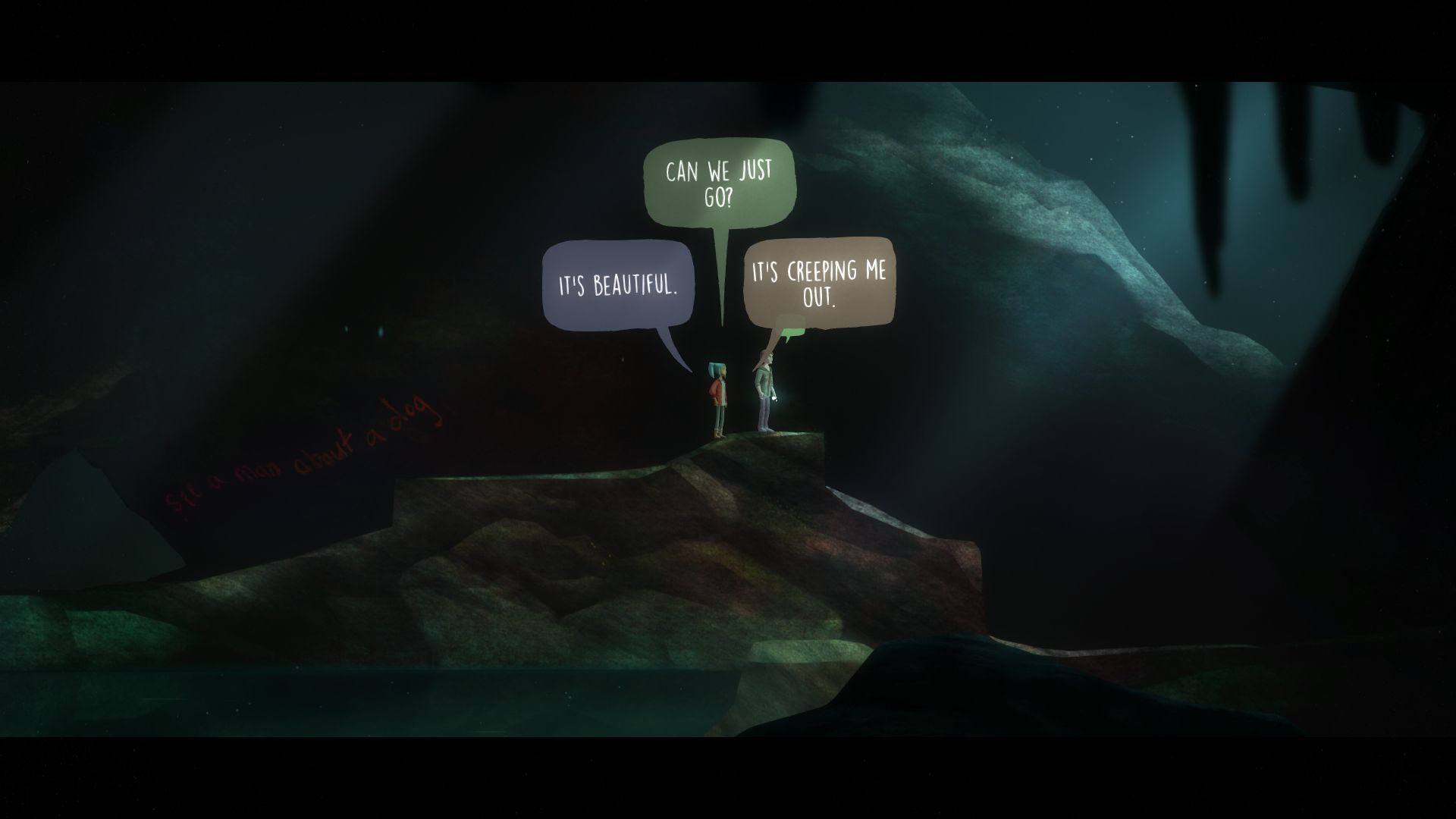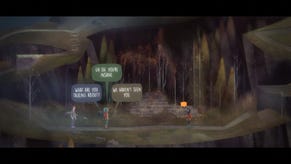Oxenfree and the horror of grieving
Drowning is also a metaphor
Night School Studio's new game, Afterparty, just came out, and since it involves you drinking your way around literal hell, it would seem every bit the fitting Halloweeny treat. But taking a look back at Oxenfree, the point and click mystery that was the studio's first outing, it's impressive how much it stands up as its own spooky experience. It's not just spooky either, but funny, thoughtful, unnerving, and outright terrifying.
Early on in the story, deep trauma is revealed, relating to grieving and touching most of the central characters: Alex, the protagonist, lost her brother Michael, while her new stepbrother Jonas (who is now occupying Michael's old room) lost his mother. Both appear to be dealing with their respective losses as well as can be expected. But there's a lot there - and it's at the heart of the game. Because while Oxenfree has its supernatural elements, its horror doesn't come from traditional jump scares or big toothy monsters. It comes from how the weirdness that transpires teases and pulls at these complex, bottled feelings.
The story begins with the main characters headed to an abandoned island, once a military base, to drink and party and screw around with a radio -- an annual event for students at their school. Ren, Alex’s friend, has convinced Alex to bring the radio because there are rumours that if you tune to the right frequency in the island’s caves, you can pick up stations that don’t exist. This setup paves the way for plenty of eerie, radio-based puzzles.
But the heart of Oxenfree is in the emotional gutpunches of the story, conveyed through abundant spoken dialogue options and sinister visual storytelling. Night School co-founder Sean Krankel said on IGN Unfiltered, “If every other studio’s going, ‘Story is this connective tissue between what the real gameplay is,’ we’re like, ‘How do we just make the gameplay story?’”
Night School's attempt to tackle this question led to some pretty elegant game design solutions. The PC controls are as restrained as any you might find on console: walk with WASD, spacebar for all Alex's actions (grabbing a beer, jumping a gap, or pushing a dumpster to get over a fence to the beach, for example), and shift to bring up the radio. You can even mousewheel through the frequencies. All this is kept to minimum complexity, allowing the story to take centre stage. Krankel said in his 2017 GDC talk that at one point they were looking into the characters having a Ghostbusters-style backpack device. It wasn't necessary: the pared-down, innocuous use of the radio lets the story feel as weighted as it needed to be. And it's pretty heavy.
The best horror stories, modern or old, are at their most scary when they work with implications, suggestions, and the emotional burdens they confer. Think of Let the Right One In, Get Out, or James Whale's Frankenstein.
Grief is a prism that reflects ourselves, reflects the ones we’ve lost, and looks different in different lights. Writer Adam Hines, co-founder of Night School, created an 1,800 page script for this 5-hour game, which lets the player react to situations in very many ways. On top of that, full voice acting from talented actors helped breathe Alex and her friends to life. If Oxenfree’s many dialogue trees, mysteries in multiple playthroughs, and open-ended endings point to any message, it’s that a single outlook or idea can never encapsulate a life (or a death). Our lives, thoughts, and points of view are always splitting. And grief breaks us down further.
In Alex and Jonas’s case, it may be trapping them. Getting free of what’s haunting them becomes the crux of the game: they're haunted not just literally by ghosts from a submarine wreck decades in the past, but figuratively by their own emotions. Visual and temporal distortions plague the characters -- because the best horror (and the worst grief) distorts your perception of reality. What you know to be true is not always the truth.
Krankel said, also in his GDC talk, that the team decided early on that there would be no cutscenes, and that control would never be fully wrested from the player. The game’s 2.5D viewpoint, with its pulled-back camera, came from this decision. Its distant point of view helped me focus on the story and the creeping questions it posed, instead of letting scares dominate the playthrough. But it also contrasts with the way that characters in the game are possessed by the trapped ghosts, blacking out to wake up somewhere else on the island.
What makes tropes like poltergeists and possession so terrifying? It’s the idea that you’re out of control, your fate held in unknown hands; it's that nightmare you have where you can't wake up. It's often used as both a metaphor for other ways control can be taken away from you, and it's an instant signifier of horror. To me and many others, for example, it was the scariest part of Get Out; both a surface level fear of being forced to be a spectator to your own body, and a metaphor for systemic silencing and marginalisation. In Oxenfree, however, it feels closer to the sinister, consuming force of grief as portrayed in The Babadook, where a widow is possessed and manipulated by an all-encompassing monster, to the point of almost harming her son.
Oxenfree is a game where the past intrudes on the present at every turn. Look closer again, and you see it in the environment of the island: it begins with a grey-skied boat ride, and only grows moodier and scarier, with sensitive attention paid to the watercolor-like textures of the backgrounds. Prisms and triangle shapes provide the central means by which Alex contacts the spirits of the shipwreck, and their perfect geometry contrasts with the jagged, craggy natural shapes of the island.
Take a step back and you can see the whole game is tinged with the past for us as players. It takes place in the Pacific Northwest, recalling the well-worn hip horror of Twin Peaks. Krankel said that although these Spielbergian 80s tropes are well-trodden in film and literature by now, they’re much less so in the more nascent art form of games -- but that doesn't mean we don't recognise them when we see 'em.
Stanley Kubrick, during the making of The Shining with Jack Nicholson, told Nicholson that he considered it an optimistic movie, because in his view any story that showed life after death of any kind was optimistic. And, as the sweeping score suggests in the story’s first nostalgic act, there are rays of hope throughout the narrative. Maybe, the story suggests, a connection to those we’ve lost is worth the fear.
In Oxenfree, the choices you make as Alex inform her the relationships she and her friends will end up with -- does she encourage her friend to shoot for the girl he likes? Is she nice to her brother's former girlfriend? -- but you can also choose to sacrifice one girl in exchange for everything else. And if you do that, it's as if she never existed. She is not grieved, because nobody feels her loss at all. But you can also, if you're careful in how you untangle the game, send a message even further back through the past, and save Alex's brother. Isn't that what every grieving person wishes they could do? And yet it feels a little like cheating. Cheating is sometimes allowed in games.
Oxenfree has many tangled threads, waiting to be sifted through by players. In The Babadook, grief can never be entirely banished, but we can live with it, even if threatens to overwhelm us sometimes. It is a part of human life. If grief is a prism, it can also be also be a gem or a crystal: valuable for what it lets us see, valuable because it provides contrast to our breathing lives, valuable just because it is.











